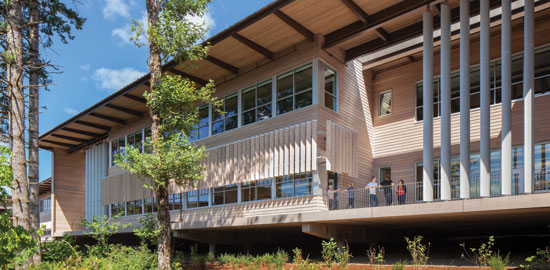Natural Winner: Western Red Cedar and Nonresidential Building
Life-Cycle Considerations
For projects like Sandy High School, these best practices in forest management and conservation may seem distant and exotic, even though they contribute to LEED certification and other green standards. More immediate, however, are questions about green building that affect the occupants, the learning environment, and the long-term fiduciary obligations of the school district. Of increasing urgency, for example, is the use of life-cycle assessment (LCA) and cradle-to-cradle analysis, which “addresses major environmental impacts throughout the complete life cycle of a product, from extraction of raw materials, the processing of those materials, manufacturing of the product, transportation, use and final disposal, reuse or recycling,” according to environmental consultant Joel Ann Todd. Under LEED v4, she adds, credits will increasingly support a life-cycle approach in building material choices, particularly in the Materials & Resources (MR) category.
LCAs and EPDs
In recent life-cycle comparison studies, says Mackie, western red cedar compared favorably with vinyl decking and composite decking, as well as in vertical applications as siding when compared to brick, vinyl, fiber-cement, and other materials. The independent LCA study, undertaken by the Canadian forest products researcher, FPInnovations, showed that the use of renewable western red cedar “produces fewer greenhouse gases, generates less water and air pollution, [and] requires less energy to produce than alternatives.” These studies will benefit buildings projects, as will an Environmental Product Declaration (EPD) “or another approved form of reporting that discloses the required LCA-based information,” says Todd, and can be provided by the manufacturer. Mackie adds that EPDs have been available for western red cedar siding and decking products since April 2011.
 |
The balcony fins of western red cedar create a memorable image for the exterior of Sandy High School, designed by the firm Dull Olson Weekes–IBI Group Architects. Photo by Josh Partee |
For recent institutional projects like Sandy High School and commercial works like the new six-story mixed-use building AVA Ballard in Seattle, which mixes western red cedar exterior panels with bright orange balcony guardrails, life-cycle performance was essential. But so was installed first cost, a sum of “initial expenditures involved in capitalizing a property, [which] included such items as transportation, installation, preparation for service, as well as other related costs.”2 “In both cases, the architects and owner groups had limited experience with western red cedar, but they wanted to achieve a certain look,” says Mackie, who consulted on behalf of WRCLA Architectural Advisory Services. “And when initial cost data was submitted for the exterior skins, they found western red cedar to be surprisingly affordable compared to other materials.”









